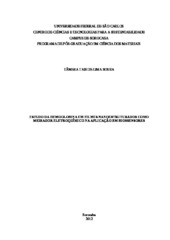Estudo da hemoglobina em filmes nanoestruturados como mediador eletroquímico na aplicação em biossensores
Abstract
The layer-by-layer technique is one of the most used in the immobilization of molecules of biological interest, being largely employed in the fabrication of modified electrodes for biosensors. One of the main challenges in the development of biosensors is to eliminate interfering electroactive species within the detection system, therefore, this problem can be solved with the introduction of inorganic or organic electron mediators. Here, we carried out systematic studies for the application of hemoglobin acting as an electron mediator, and the self-assembly technique was used to immobilize haemoglobin in nanostructured thin films. The LbL films were tested with two polyelectrolytes, obtaining uniform films with activity kept during 15 days, without responses to possible interfering phospholipids. The layer-bylayer technique was also used to immobilize the enzyme cholesterol oxidase, alternated with different polyelectrolytes. The thin films showed a good performance as an amperometric biosensor for the detection of cholesterol at low concentrations (10-5 M), with the functioning of the biosensor attributed to the use of hemoglobin in mediating the effects of excluding interfering ascorbic acid and uric acid. Some tests were also performed in real samples using
egg yolk, with good results obtained. The high sensitivity and selectivity of the biosensor have been attributed to the nanostructured thin nature of the films, despite recognition capability of the biomolecules used, with a strong potential to contribute for new device
technologies for food analysis.
